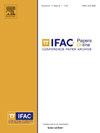On the rate of convergence of distributed relaxed-ADMM algorithms in distributed optimization
Q3 Engineering
引用次数: 0
Abstract
In this paper, we present a preliminary analysis of the convergence rate of the relaxed ADMM-based algorithm recently introduced in the literature for distributed optimization problems. It is well known that the relaxed ADMM is a more general algorithm than the classical ADMM. Indeed, while the performance of the latter typically depends on one parameter, say p, the performance of the former depends on two parameters, say p and a, and the relaxed ADMM reduces to the classical ADMM when α = 1/2. Interestingly, from a computational point of view, the presence of the additional parameter a does not significantly complicate the updating steps of the algorithm. Nevertheless, the relaxed ADMM is much less considered in distributed optimization problems than the classical ADMM. In this paper, we show that by restricting to quadratic functions with the same convexity and to communication graphs that are regular connected graphs, it is possible to analytically compute the eigenvalues of the matrix that governs the dynamics of the algorithm based on the relaxed ADMM. Based on these eigenvalues, it is possible to design an efficient numerical procedure to evaluate the rate of convergence and to optimise it with respect to both α and p. Our results show that, by properly tuning the a parameter, the relaxed ADMM can can achieve superior convergence rates compared to its classical ADMM counterpart; in particular, for the family of graphs we considered, the optimal a typically tends to 1 as the number of agents increases. The analysis we present is preliminary, but suggests that the use of the relaxed ADMM can significantly improve the performance of the classical ADMM when applied to distributed optimization problems, at the price of a slight increase in computational complexity.
分布式松弛admm算法在分布式优化中的收敛速度
在本文中,我们对文献中最近提出的基于松弛admm的分布式优化算法的收敛速度进行了初步分析。众所周知,与经典ADMM相比,松弛ADMM是一种更通用的算法。事实上,后者的性能通常取决于一个参数,比如p,而前者的性能取决于两个参数,比如p和a,当α = 1/2时,松弛ADMM减少到经典ADMM。有趣的是,从计算的角度来看,额外参数a的存在并没有显著地使算法的更新步骤复杂化。然而,在分布式优化问题中,与经典ADMM相比,松弛ADMM较少被考虑。在本文中,我们证明了通过限制具有相同凸度的二次函数和正则连通图的通信图,可以解析地计算基于松弛ADMM的控制算法动力学的矩阵的特征值。基于这些特征值,可以设计一个有效的数值程序来评估收敛速度并对α和p进行优化。我们的结果表明,通过适当调整a参数,与经典ADMM相比,松弛ADMM可以获得更好的收敛速度;特别是,对于我们考虑的图族,随着代理数量的增加,最优a通常趋向于1。我们提出的分析是初步的,但表明,当应用于分布式优化问题时,使用宽松ADMM可以显着提高经典ADMM的性能,但代价是计算复杂性略有增加。
本文章由计算机程序翻译,如有差异,请以英文原文为准。
求助全文
约1分钟内获得全文
求助全文
来源期刊

IFAC-PapersOnLine
Engineering-Control and Systems Engineering
CiteScore
1.70
自引率
0.00%
发文量
1122
期刊介绍:
All papers from IFAC meetings are published, in partnership with Elsevier, the IFAC Publisher, in theIFAC-PapersOnLine proceedings series hosted at the ScienceDirect web service. This series includes papers previously published in the IFAC website.The main features of the IFAC-PapersOnLine series are: -Online archive including papers from IFAC Symposia, Congresses, Conferences, and most Workshops. -All papers accepted at the meeting are published in PDF format - searchable and citable. -All papers published on the web site can be cited using the IFAC PapersOnLine ISSN and the individual paper DOI (Digital Object Identifier). The site is Open Access in nature - no charge is made to individuals for reading or downloading. Copyright of all papers belongs to IFAC and must be referenced if derivative journal papers are produced from the conference papers. All papers published in IFAC-PapersOnLine have undergone a peer review selection process according to the IFAC rules.
 求助内容:
求助内容: 应助结果提醒方式:
应助结果提醒方式:


